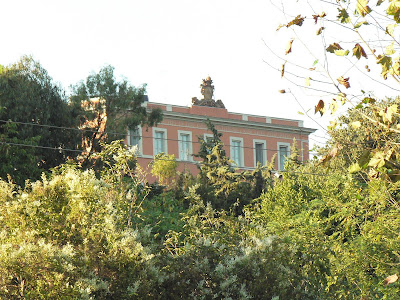I have my morning coffee in our dining room where I can look out the window and see the parish church of St. Philip Neri. (The building was donated by Thomas and Irene Bradly of New York City in 1952.) At about 7:30 a.m. I leave the apartment and begin walking along the Via della Sette Chiese to the bus stop. I pass a small old church dedicated to Saint Isidoro, patron of farmers, and to Saint Eurosia, to whom farmers appealed when they feared hail would destroy their crops. It was originally a chapel belonging to the Paradisi family and served the few inhabitans of the nearby farms. (Our modern neighborhood of Garbatella was built during the 20th Century.)
I have a 6-7 minute bus ride to the Basilica of St. Paul Outside the Wall, where I change busses. My next bus takes me across the Tiber River, and after another 6-7 minute ride I get off at the ancient church of Santa Passera. The final part of my commute is a 10 minute hike to the top of the hill. I walk past the Church of the Holy Family and enter the gate of my school.
 The Church of St. Philip Neri
The Church of St. Philip Neri Thomas and Irene Bradley of New York
Thomas and Irene Bradley of New YorkThe Via della Sette Chiese is the 12 mile route used by St. Philip Neri (1515-1595) to visit seven churches dating from the 4th Century. In his work with young people, he organized evenings of meditation, songs and readings. He held processions that visited seven churches in Rome with stops not only for prayers and silent devotion at each church but also for singing, dancing and a massive picnic — a real party attended by as many as 6000 people. St. Philip Neri is my kind of saint! I have seen priests leading young people by our apartment, probably retracing the steps taken by others for 500 years. (The seven churches are San Pietro in Vaticano, San Paolo fuori le Mura, San Giovanni in Laterano, Santa Maria Maggiore, Santa Croce in Gerusalemme, San Lorenzo fuori le Mura, and San Sebastiano fuori le Mura.)
 "Rome and It’s Seven Churches" in an etching by Etienne Duperac, 1575.
"Rome and It’s Seven Churches" in an etching by Etienne Duperac, 1575. The Church of SS Isadoro e Eurosia
The Church of SS Isadoro e Eurosia This is how I see the Basilica of St. Paul from the bus stop.
This is how I see the Basilica of St. Paul from the bus stop. The Church of Santa Passara
The Church of Santa PassaraThe Church of Santa Passera celebrates the arrival in the 5th century of the relics of the Coptic Saints Cyrus and John of Alexandria who were killed during the time of the Emperor Diocletian. The church is located at a large turn of the Tiber River, opposite the Basilica of St. Paul, and it served a small community of miners exploiting the tufa quarries of the nearby hills. When the current building was erected in the 9th century it made use of an existing 3rd century Roman tomb. The reference to Passera is uncertain, as there is no saint with such a name. Some think it is probably a linguistic twisting of the original name of Abba Cyrus.
 The school building as seen from the church of Santa Passera.
The school building as seen from the church of Santa Passera.  You can see my classroom windows above the front door of the school building.
You can see my classroom windows above the front door of the school building.

1 comment:
Neat walk! And great views.
Post a Comment